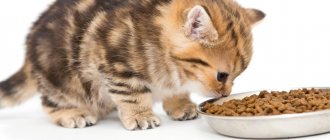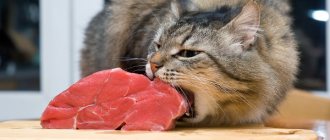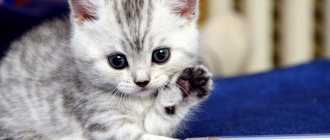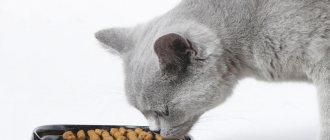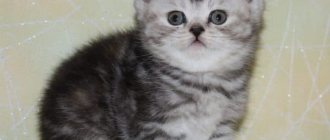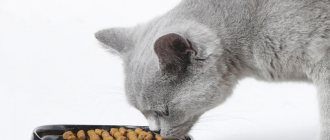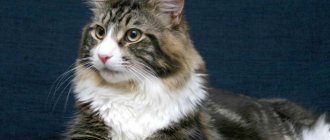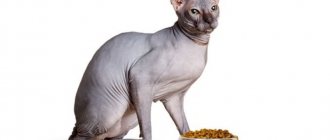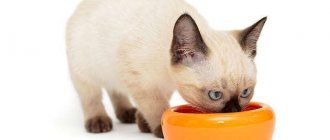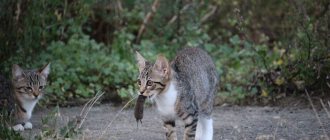Many people think that feeding a kitten is simple, because for centuries our ancestors in the villages simply gave the leftovers of dinner to their pets. It seems that it is enough to pour the remaining soup into a bowl, add a little meat or fish - and all this is enough for your pet. As a last resort, you can buy the most ordinary food in the store and not have to worry about choosing a menu. But everything is not so simple if you want your pet to be healthy, vigorous and live a long time. There are some nuances in creating a diet for kittens.
Factors influencing diet
The body's need for more or less food directly depends on what physiological changes occur in it throughout life.
If you follow your pet's lead and give him food every time he asks, there is a risk of overeating, and as a result, obesity. Therefore, it is important for the owner to create a feeding schedule and monitor the pet’s weight. The serving size should always be the same and appropriate to the needs of the cat depending on its weight, age, breed, activity.
- We want to eat.
Attention! If your cat regularly leaves uneaten food, the portion size should be reduced.
After 15-20 minutes have passed after the animal is full, the bowl of food is removed and the remaining food is disposed of. The possibility of a cat being poisoned by a spoiled product must not be allowed. The dishes are washed and dried, preparing for the next feeding. There should always be a bowl of clean water near the food bowl, which is changed daily.
It is important to monitor the amount of water you drink, especially if your pet eats ready-made dry food. Often cats prefer to drink water from household utensils: buckets or basins. It is necessary to ensure that the water in such containers is always fresh and clean. Refusal to drink or excessive thirst is a reason to contact a veterinarian. Perhaps the food is not suitable for the animal, or it is possible that this is a symptom of a disease.
If a cat quickly absorbs food, but does not get enough, constantly begs for food, and does not gain weight, it is necessary to examine it for the presence of parasites.
In summer, a cat's appetite worsens due to the heat - the pet spends most of the day dozing, drinking water, eating little by little early in the morning and towards night. And in the fall, the predator’s appetite increases, because by winter it needs to gain weight and restore its coat.
A cat's health also affects its appetite. The need to take medications, their possible side effects, and the nature of the disease are factors that reduce a cat’s interest in food.
For feeding and drinking, it is best to use wide cups with low sides. If you are keeping several pets, dishes with food should be installed at different levels or in different rooms so that the animals eat calmly, do not rush and do not try to take food from each other.
Products undesirable for kittens
Despite the fact that 20 years ago in villages cats were fed leftovers from dinner, and the animals did not have any problems with nutrition, modern pets have a more sensitive digestive tract.
In addition, they live in different conditions, and their immunity is not adapted to survive extreme situations. That is why it is better to exclude the following products from the animal’s diet:
- sausages, sausages, smoked meats;
- rice;
- bread and buns;
- margarine and butter;
- pasta;
- mushrooms and legumes;
- tomatoes;
- sweets.
Of course, nothing will happen to the kitten from one piece, but systematic consumption of such products will shorten the pet’s lifespan.
Dangerous foods for kittens
It is important to eliminate raw foods from your diet whenever possible. This is especially true for pork and river fish - they contain a lot of worms. It is better to boil and chop these products or replace them with lean meat and sea fish. You should also avoid seafood (shrimp, mussels).
Extremely dangerous products
Chocolate is very dangerous even for adult cats. Its consumption can cause the death of the animal. This product contains theobromine, which is absolutely not excreted from the cat’s body and accumulates in dangerous concentrations. The same applies to large bones, fragments of which can injure internal organs. It is strictly forbidden to give kittens expired food and medications prescribed for humans.
Also, depending on the breed, there may be certain dietary restrictions. For example, Maine Coons do not really like fish and digest it poorly, and Sphynx cats should not be given fatty foods.
How many times a day should you feed a kitten?
The needs of a kitten’s growing body and its physiology are significantly different from the needs of an adult animal. Consequently, the approach to feeding babies is different.
It is necessary to follow the feeding regime
The kitten must be fed, strictly observing the time interval between meals and dosage:
- From 0 to 2 months, a baby, left without a mother for some reason, is fed around the clock, every 3 hours.
- From 2 to 3 months, complementary feeding begins. The baby is fed every 4 hours, regardless of the time of day.
- From 3 to 6 months of age, the animal should receive food 3-4 times a day, excluding feeding at night.
- From 6 months to 1 year – 2-3 times a day.
- Over 1 year – 2 times a day.
In the morning, you can leave double the amount of dry food in the bowl if the owner is at work until the evening. A healthy kitten will not eat more than it needs. But it is not recommended to keep food freely available for kittens and cats prone to overeating.
For active growth and harmonious development of a kitten, for every 100 g of weight, the following is required daily:
- 30 ml of formula - for 1 feeding until the 4th day from birth;
- 40 ml – from 5 to 14 days;
- 45 ml – from 14 to 21 days;
- 50 ml – from the 3rd week.
Optimal time to start complementary feeding
Owners often have questions about when to start feeding kittens and what is best to feed them – natural food or ready-made industrial food.
Complementary foods can be introduced into the diet of kittens 20-21 days after birth. This procedure must be carried out up to six times a day, every 3-4 hours. Complementary feeding for kittens is usually started simultaneously with the consumption of mother's milk. Food is an addition; it must be soft, warm, and the portions are small, because babies have not yet learned to chew.
If you plan to feed your cat dry food in the future, you can make a paste out of it and give it to the kittens. The store sells special food for tailed babies of different breeds. Several pads are soaked in water and carefully spread on the kitten’s palate. Then a bowl of food soaked in water is placed in front of him. Gradually he must understand what is required of him. The amount of water added to the food should be gradually reduced, and by two months the baby will be able to chew the pads on his own.
How much should a cat eat per day?
To keep your pet healthy and alert, its diet must be nutritious and balanced. It is the nutritional value of the product that determines how many times a day you need to feed your cat. The amount of food eaten during the day should be no more than 7.5% of the animal’s weight.
The dosage of ready-made food is indicated on the packaging, and with natural feeding, the cat needs to eat up to 150 g of meat or fish per day, which is 50% of the daily protein intake. The natural diet is supplemented with fermented milk products, cereal porridges, seasonal vegetables, vitamins and mineral nutritional supplements. Meal frequency – 2 times a day.
- Can I have a piece?
The diet of a pregnant cat should have an increased energy value: contain more vitamins and minerals, but not increase the calorie content of the product. Increase the frequency of feedings up to 4-5 times, maintaining the usual serving size. A nursing cat is also provided with frequent feeding, while increasing the volume and calorie content of food.
Note! It is better to prepare the diet for a pregnant or lactating cat after consultation with a veterinarian.
General recommendations
If it is decided that the kittens will eat only natural food, it is advisable to accustom the pets to eating a variety of foods from the first month. You should not give your animal one product he loves and make it the main one in his diet. This can lead to digestive problems.
A great danger to a kitten's health is feeding human food in combination with ready-made food. It is also not recommended to mix expensive dry food with cheap wet food. It is better to leave only dry food, since low-quality wet food will do nothing but harm to the kitten.
Pay attention to the kitten’s fur as often as possible: if it is shiny and smooth, then the pet is healthy. If bald spots appear or the skin under the fur is irritated, you need to consult a veterinarian and purchase a special vitamin complex. But remember that in a good ready-made food, all nutrients and microelements are already balanced.
Feeding standards
The amount of food per meal depends on its type and type of feeding. Veterinarians recommend keeping domestic cats on a natural diet, regularly using vitamin and mineral supplements, and following a two-time feeding regimen (morning and evening).
An adult healthy animal should be provided with at least 10 g of protein, 2 g of fat, 1 g of carbohydrates, 1 g of fiber per 1 kg of weight per day. The daily energy value for natural feeding should be at least 40 kcal per 1 kg of weight.
Drinking regime
To digest solid food, more liquid is required, so with the introduction of complementary foods it is necessary to pay special attention to the drinking regime. Change the water in the bowl every day, and in the summer - 2 times a day. Otherwise, bacteria and other harmful microorganisms will accumulate in it.
Remember that animals can only be given bottled water from the store or filtered water. Tap water contains metals, salts and other dangerous deposits that can harm the body.
Unconscious eating: from the first minutes to a month
As soon as it is born, the kitten can only breathe. He does not see or hear the world around him. His main task in the first week is to survive. To do this, the mother constantly feeds him every two hours with her milk, the temperature of which is not lower than 38-39 0 C. This indicator is considered normal for cats, the same as for people 36.6 0 C. Newborn kittens are not yet able to maintain their own temperature at the required level, but they die from hypothermia. The cat, under whose tummy they hide, worries about their warmth.
The above factors should be taken into account by those owners who, for various reasons, are forced to feed their cat babies without a cat from the very first days of their life. If you have a newborn kitten, from the first hours to the fifth day it should be fed every two hours (around the clock!) with warm milk formula (38-39 0 C), which can replace cat milk in composition. You can prepare it yourself or purchase it at a pet store. Formulas for newborn babies are often used, diluted with water to the desired state.
From the fifth day, the number of feedings is reduced by half, that is, now you will need to get up every four hours at night, and do not forget to feed the baby every four hours in the bustle of the day. This feeding frequency will last until the end of the first month.
The temperature of the formula should be gradually lowered, as babies become more and more capable of regulating their heat exchange every day. This should be done in this order:
- until the end of the seventh day, 38-39 0 C remains;
- until the end of the second week - 30-32 0 C;
- third week - 28-30 0 C;
- from the fourth week onwards - 24-26 0 C.
Those dedicated breeders who decide to feed newborn kittens on their own should also acquire very accurate scales. Based on them, it will be necessary to determine the daily dose of the mixture daily for every 100 grams of the pet’s weight, which should be calculated according to the following scheme:
- from 1 to 4 days - 30 ml;
- from 5 to 13-38 ml;
- from 14 to 24-46 ml;
- 25 x 35-53 ml.
The average weight of a newly born lump usually does not exceed 120 grams. Every week it should increase by 100-160 grams. For the first 14 days, babies are fed from a bottle into which the daily dose is placed. At each feeding (after two or four hour intervals, depending on age), the kitten will eat the dose it needs. It is quite simple to find out that your pet is full during this period - he stops sucking the bottle. From the 15th day it is necessary to begin to accustom them to a bowl or saucer so that they gradually master independent feeding.
How to feed a small kitten: features and rules
There are certain rules and nuances of feeding a kitten. This applies to both the feeding regimen and procedures after it.
What things will you need?
To feed a kitten, you will have to purchase some items. A bottle with a special nipple will be more convenient for you and better for the animal: such a thing is sold in a veterinary pharmacy. It has an anatomically correct shape and resembles a cat's nipples.
You can feed newborn kittens without a cat either with a pipette or with a syringe without a needle. But this option is undesirable, since during feeding, air may enter the esophagus or milk may enter the respiratory tract, causing the animal to choke or regurgitate. It is very important to wash and sterilize items after each feeding.
Stages of the procedure
When everything you need has been collected and sterilized, dilute the mixture according to the instructions and heat it. It is not recommended to do this in the microwave - the mixture may warm up unevenly - it is better to heat it in a water bath.
Check your pet's body temperature. If the paws are cold, the kitten is cold, which means the food will be digested much worse. The baby must be kept warm at all times. To do this, place a heating pad wrapped in a towel or a bottle of hot water in his box or house.
When you are sure that the kitten is warm, you can proceed directly to the feeding process. To do this, lay a towel on your knees, carefully lay the kitten on its stomach and lift its head a little - this is the position in which kittens feed from their mother. For the very first time, you should moisten the nipple's spout with milk so that the baby smells the food and begins to eat.
How to determine if a kitten is full
Both conditions are extremely undesirable and even dangerous for a baby: underfeeding and overfeeding. If he doesn't get enough food, he doesn't gain weight well and appears lethargic. Overeating is indicated by loose stools in yellow, green and gray shades. You can visually determine whether the kitten is full in the following way: extend your finger to it. If the animal begins to suck, then it is not full.
The baby’s behavior is also an indicator. If the kitten is full, he simply turns away and falls asleep, sometimes milk bubbles come out of his mouth, if not, he squeaks, crawls and looks for a pacifier.
What to do after feeding
During the process, try your best to ensure that the animals are calmed by your voice. Talk to them and be sure to pet them, and after feeding, wipe off any remaining food from their faces.
At the end of feeding, lightly press the kitten's back against your stomach and gently stroke its tummy. With these actions you stimulate belching and start the process of digesting food.
To prevent kittens from suffering from constipation, it is necessary to massage their anus. This is done with cotton pads or ear swabs, which are dipped in Vaseline.
Artificial stimulation of peristalsis does not always help, and babies experience stool retention. In this case, you need to give an enema, but it is better to do this under the supervision of a veterinarian - leave the procedure to him for the first time, later you will learn how to give enemas to kittens yourself.
Formative nutrition: from the first month to six months
Now all the sleepless nights are over and your kittens begin to confidently stand on their feet, get out of the nest, bully each other, run to the kitchen in search of food - in a word, the body has survived and its active formation has begun. During this period, the main body weight gain occurs. Every day the kitten asks for more and more food, sometimes it becomes capricious, turns up its nose, and sometimes it devours the entire portion; all you have to do is replenish the bowl.
At this age, breeders should provide the baby with food in sufficient quantities so that he always has enough energy for development and play. In addition to calories, during this period of life a kitten needs to consume all the building material from which its body will be formed, and, consequently, its future health. To do this, breeders begin gradually feeding babies a wide variety of foods.
The calculation of the number of feedings during this period is still determined by weight. Now 1 kg is taken as a basis. The daily dose for a kilogram kitten is 150-250 grams of a balanced diet. This means that your daily intake should include proteins, vegetables, cereals and fermented milk. Moreover, in the first month their ratio will be more towards liquid mixtures, and by the fifth month the diet should already contain more meat products. The most common scheme looks like this:
- 1st and 2nd months - 5 meals a day: every 4 hours, skipping one night feeding (break 8 hours);
- 3rd and 4th months - 4 meals a day: every 4 hours, skipping two night feedings (12 hour break);
- 5th and 6th months - 3 feedings per day.
Although the kitten eats less and less every month, this does not mean that it needs to be fed less and less. In no case! On the contrary, now is the time to eat a lot, even more adult cats. It’s just that now the portion size should increase, since the kitten’s stomach expands every day. It is no longer a problem for your baby to fit the right amount of food into it at one time. In the morning, it is advisable to give fermented milk, in the afternoon - mixtures of cereals, vegetables and meat, in the evening - meat products (so that the hunter sleeps at night and does not look everywhere for the treasured game).
Setting up a den for newborn kittens
Even the tiniest, still blind kittens can scatter in search of their mother, food or a source of warmth. To avoid trouble, it is necessary to exclude the possibility of escaping from the “nest”. The traditional, time-tested option is a cardboard box. Newborn kittens will not soon be able to get out of it on their own. The box should not be a shoe box, but with high walls.
Cardboard is a warm and safe material, and if the box becomes unusable, you can simply throw it away and replace it with a new one. An alternative is a deep plastic box or container, but in this case the ventilation is worse, and the container itself will have to be washed and disinfected periodically.
Place bedding on the bottom. A convenient option is disposable absorbent diapers, but the downside is that it can bunch up and clump if you do not attach it with tape or an adhesive edge. Fleece has proven itself to be excellent - it dries quickly, is warm and soft. Woolen products are absolutely not suitable, although they are often placed on kittens for “entourage”. The claws may get tangled in the fur, causing injury to the kitten. In addition, babies acquire the bad habit of sucking wool and may swallow thread.
Reflex feeding: six months to a year
When they reach six months, kittens are already transferred to the category of teenagers who have practically gained the required weight and can now get used to adult food twice a day. If the plans include sterilization of the animal, then this should also be done before a year, after which feeding more than twice a day will generally be contraindicated, and the ideal option for such animals is one-time evening feeding.
It is very important during this period to accustom the kitten to a regular diet. To do this, try to remove the bowl after each feeding so that the baby learns to hunt and get food, and not lazily find it at the slightest whim. Then your future mustachioed friend will have a playful character and will also move a lot in adulthood. This will protect him from obesity.
Upon reaching six months, and for some breeds even earlier, the breeder should finally decide on the form of nutrition - will it be ready-made or natural food? It is equally important to choose the final manufacturer (if you plan to feed “dry” rather than “natural”) in order to begin to consistently accustom your pet to your preferences. If you do not establish eating habits at this age, after a year your pet will dictate terms to you.
Features of complementary feeding of individual breeds
When introducing complementary foods and preparing a diet, you need to take into account the characteristics of cat breeds. For most species, standard rules apply. But there are breeds that have certain characteristics that require correction in the complementary feeding regime.
Ragdoll kittens have a genetic disease: hypertrophic cardiomyopathy (thickening of one of the walls of the heart ventricle) and joint dysplasia. Therefore, the list of prohibited products additionally includes: meat of geese and ducks, cream, and fatty sour cream. Their consumption negatively affects cardiac activity and disrupts metabolism.
Little ragdolls
Sphynx kittens (like other representatives of hairless breeds) have a high risk of developing cardiovascular diseases. They can only be given dietary meat: turkey or chicken, rabbit, beef. Pork should not be given to any cats, and especially not to sphinxes. To start feeding, raw or boiled veal is suitable.
A Sphynx kitten needs to be fed more often than a regular cat. Six to eight meals are recommended up to two months, four meals up to five months. At the age of six months, reduce the frequency of feedings to three times a day, and from the age of nine months, accustom them to two meals a day.
Sphynx kittens
Maine Coons mature late. Cats usually feed their babies for up to two months. These kittens do not need to be fed complementary foods until they are 8 weeks old.
Maine Coon kittens differ from all others in their large size. Accordingly, more food is needed. At the age of two months, kittens should receive 130 grams of meat, up to 40 grams of vegetables and dairy products, and about 15 grams of cereal. For other breeds, this is the norm for an adult cat.
Maine Coon kittens are larger than kittens of other breeds
Recommended menu for feeding kittens
Finally, it is worth mentioning a few words about expanding the diet as the baby grows older. Here's what its menu might look like:
- 1 month - add liquid semolina porridge and chopped boiled yolk to the milk mixtures (once a week);
- 2 month - infant formula is replaced with milk, calcined curds (not store-bought!), they also begin to feed with liquid porridge and crushed boiled meat, soft natural cheese without flavoring should be given once a week;
- 3 month - the porridge is no longer cooked liquid, but of normal consistency, you can give boiled meat in cubes, grated vegetables, kefir, scalded raw meat are added to the diet;
- 4th month - porridge, pieces of meat (both boiled and scalded raw), grated vegetables, cheeses, fish (once a week);
- from the 5th month, the kitten’s menu should no longer differ from the menu of an adult animal, but the kitten needs to be fed more often and more, and it is also necessary to give dry rye bread to strengthen its teeth.
When do kittens need artificial feeding?
The ideal situation is as follows: the cat cares for and feeds the kitten until it is approximately 8 weeks old. Only then can you separate the baby from his mother. But there are times when human intervention and help is required. Reasons why this may happen include:
- death of a cat;
- lack or deficiency of milk in her;
- mastitis and inflammation of the uterus in a cat;
- eclampsia in a cat, that is, calcium deficiency;
- psycho-emotional deviations of the animal.
Sometimes the mother feeds the kittens regularly, but the babies still need complementary foods. This situation may arise if the litter is very large. It happens that a weak kitten is born, which quickly gets tired when sucking - in this case, it also needs additional nutrition. How you manage to feed a kitten without a cat or simply intervene a little in the process will determine its future health.
How many times a day should you feed a kitten?
In the first days of life, kittens feed every 2 hours, regardless of the time of day. During the period of 2 weeks of age, you need to feed every 4 hours both during the day and at night.
After the baby has switched from mother's breast milk to solid food, he should be fed several times a day in small portions.
- for 1-2 months, feeding small kittens should be 7 times a day;
- for 3 months — 6 times a day;
- for 5 months - 5 times;
- at 9 months - 4 times;
- by one year - 3 times a day.
How to tell if a kitten is full
For a certain age of a kitten, there are standards: how many times a day and how much he should eat. Before and after feeding, the kitten can be weighed on a kitchen scale, which will allow you to track how well your little pet is eating.
Also, at a young age, after feeding, kittens have a pronounced rounded, well-fed tummy. Another indirect sign is that tiny fluffies usually sleep peacefully immediately after eating.
Introducing dry food into a kitten's diet
Unlike pates and meat pieces, dry granules require the presence of teeth. This is exactly what you need to focus on when choosing the right age.
Suitable age
If you choose to feed with industrial food, then there are two options. It is easiest to feed with meat pates and spiders. They are introduced immediately after the incisors erupt.
In addition to their soft consistency, they have a pleasant smell and taste, so animals get used to them very quickly. In this case, dry granules are added when all baby teeth appear, that is, at 2.5-3 months.
Despite the benefits, not all owners can afford to buy more expensive wet food. Most choose the second option - feeding dry granules with the addition of pates in the form of treats. In this case, the introduction is also carried out after the incisors have erupted. The problem is that babies do not yet know how to chew and cannot crack hard pieces without assistance.
Do I need to soak it?
It all depends on the age of the pet. If he only has baby incisors, then he will have to get help. Soaking the granules in warm boiled water will eliminate the need for thorough chewing.
NOTE!
Use only fresh water. Adding milk or broth will lead to a mixed diet and problems with the gastrointestinal tract.
When can you start feeding only dry food?
Focus on the presence of a nursing cat. If she has enough milk and does not drive away the cubs, wait for a natural interruption of breastfeeding. If the situation is the opposite or you have taken your small pet to another home, then feel free to switch to full feeding with dry food.
Diet
When thinking about how to organize complementary feeding for kittens, at what age and how you can diversify the nutrition of small fluffy balls, it is important to focus on age. It is this factor that imposes the main restrictions on the choice of food for pets.
For a three week old kitten
There is not much choice in what you can feed small three-week-old kittens.
Instead of mother's milk, you can use a milk substitute, which is sold in pet stores, as well as infant formula (they must be without additives and sugar). Here it is important to observe the baby’s stool: if it is runny, you can dilute the milk with water. You can also slowly begin to include the following foods in your diet:
To feed the kitten, you can use a small bottle with a nipple, a pipette or a syringe without a needle. Food should be heated to a temperature of 38 degrees.
Important! It is necessary to ensure that the kitten does not choke during such artificial feeding. If using a pacifier, he must suck on his own; with a syringe, he must inject milk little by little and from a small hole.
For an average kitten weight of 280 g, on average, 80 ml of food per day is calculated.
Food for a one month old kitten
One month is the age when you can start feeding kittens. First you need to decide what the kitten will eat. These must be either natural products or certain food. The daily norm is 50-55 ml per 100 g of weight.
Do not mix natural food and feed or several types of feed. Give preference to one thing.
How to feed a small kitten natural food? At the complementary feeding stage, it is necessary to give your pet a variety of foods to get him accustomed to it. The larger the list of products, the more opportunities the kitten will have to get the necessary nutrients from food.
Natural food should not contain any additives familiar to the human body: no salt, no sugar, no spices.
To start, you can give your kitten the following foods:
- cottage cheese;
- egg yolk;
- porridge with meat and milk broth;
- lean soups with broth.
When adding meat, you need to choose the least fatty cuts, cook and grind/puree before giving to the kitten, since he cannot handle solid food yet.
Attention! Complementary feeding time is also the time when you can start feeding kittens with vitamin complexes, which can be purchased at any pet store.
- Ready-made feed
Ready-made food is an excellent alternative to natural food, because it is maximally balanced and adapted to the age and characteristics of your pet.
Specialized foods will help answer the question of what and how to feed a one and a half month old kitten. They usually also come with instructions on the order and number of meals.
The need for complementary feeding for kittens up to 1 month
The benefit of breast milk lies not only in its fortified composition, but also in the transfer of protective antibodies. Together with him, the baby receives passive immunity, protecting against infections until the first vaccinations.
If natural feeding is not possible, then artificial milk formulas are introduced into the diet. You can buy them at a pet store or veterinary pharmacy.
NOTE!
The use of goat's and cow's milk is only permissible on a short-term basis. Their prolonged use causes intestinal problems and contributes to the development of vitamin deficiency.
What a kitten shouldn't do
Focusing on proper and balanced nutrition, it is also important to know what you should not feed your kitten.
These products include:
Cow's milk, to which people are accustomed, will be poorly absorbed by the kitten's body. It needs to either be replaced or diluted.
You should not give your kitten raw meat. Firstly, he is not yet able to chew and digest rough food, and secondly, raw meat may contain worms and pathogenic bacteria.
Cheeses, butter or fatty meats will also be heavy food for a kitten and should be introduced into the diet gradually and little by little.
The kitten is not able to thoroughly chew and digest such foods on its own.
What a cat shouldn't eat
Firstly, the enamel of cats' teeth is 10 times thinner than that of humans and, when ingested by sweets, is less resistant to the effects of sugars. Secondly, sweets are a very high-calorie food for cats, which can disrupt their digestion.
Poorly absorbed by the body: it causes colic and flatulence.
You only need to choose one type of food: a specific brand of food or a homemade balanced diet.
Causes disruptions in the gastrointestinal tract.
- Tomatoes, potatoes, eggplants.
Contain substances that are considered toxins for the cat's body. They are not digested properly, either cooked or raw.
They contain a large amount of sugar, which is harmful to the kitten. May cause an allergic reaction.
Not absorbed by the cat's body.
When eating monotonous food, the kitten does not receive all the necessary vitamins and minerals in the required quantities. The diet should be varied, taking into account the characteristics of the growing organism.
If there are both cats and dogs in the house, the food should be different, as they have different compositions. Under no circumstances should a kitten be given food intended for dogs.
Ready-made feed
There are a huge number of opinions regarding which food is better - ready-made or natural. As for industrial products, the advantages here are obvious - a complete balanced diet and ease of use. The disadvantages include the presence of synthetic food additives in some feeds.
If you have chosen to feed your pet industrial food, you should consider some rules for their use.
- Do not combine dry and wet food in your diet.
- Do not change the brand of the product.
Read the manufacturer's recommendations carefully. Starting from the age of four months, the kitten can give out the entire daily portion of dry food immediately, since kittens by this time are already able to control their appetite. Wet food should be given in portions equal to a single volume and in a heated form. In order not to harm your pet’s health, it is better to choose proven and reliable manufacturers, such as: NutroChoice, RoyalCanin, Purina, Acana. The product lines of these manufacturers include both dry and wet diets. Among the most popular brands that produce food for kittens are:
- Canadian brand "Akana". The company's products belong to the super-premium category and represent a complete, balanced diet with a low level of allergenicity. Products are made from whole, fresh raw materials of plant and animal origin. Meat component - at least 70%, the rest - vegetables, seaweed, fruits, cereals, eggs. The recipe is enriched with unsaturated fatty acids, vitamins, and microelements.
- French brand Royal Canin. The optimal content of nutrients necessary for the development and growth of kittens puts the products of this brand on a par with natural nutrition. The manufacturer recommends using the food starting from the age of four months for the kitten. The company's product line also includes a series of veterinary foods recommended for consumption based on a specific disease.
Consequences of poor nutrition
In conditions of poor nutrition, an imbalance of vitamins and minerals occurs, which can lead to diseases such as:
- Diabetes. It can develop not only as a result of genetic predisposition, but also against the background of decreased immunity.
- Avitaminosis. A lack of vitamins of a certain group affects the harmonious development of the muscles, immune system and internal organs of pets.
- Poisoning. Products that are toxic to a kitten can lead to severe poisoning of the pet.
- Allergic reaction. Some products with a specific composition can have a negative effect on the pet’s body and lead to allergies.
- Shedding. Due to inappropriate feeding, a lack of essential vitamins and minerals can affect your kitten's appearance.
In order to best care for your cat, you can show him to a veterinarian at a young age and get advice on how to properly care for and what to feed the kitten from the first months and first days of life. It is important to take proper care of pets from birth, then they will delight the owner with a playful mood and a healthy appetite!
Sources:
https://zverki.click/koshki/pitanie-koshki/pravila-i-sovety-o-tom-skolko-raz-v-den-kormit-koshku.html https://porodakoshki.ru/skolko-raz-v -den-kormit-kotenka/ https://gafki.ru/koshki/cem-kormit-kotenka.html
Caring for kittens at 2 months
Touching meowing babies at two months of age remain fragile creatures. They are ready to be attacked by infections and parasites. The owner’s task is to protect the fluffies from danger. Timely vaccinations and timely deworming will help fight infections.
The veterinarian should be a friend: a source of necessary advice and regular examination.
The baby's appearance needs care: this is the time to accustom him to a comb, the procedure of washing his eyes and cleaning his ears. A healthy pet sparkles with beautiful fur and is in a good playful mood.
Is it possible to keep newborn kittens together?
If there are several kittens, they are usually kept together. This makes it easier for babies to stay warm by snuggling together. Living warmth and the presence of relatives calms and creates a feeling of security.
But there are exceptions to every rule. During the first week, kittens should not be left with each other unattended, as their umbilical cord has not yet healed. Up to the age of one month, observe how babies interact with each other. Without round-the-clock access to the mother's breast, hungry kittens can cling to each other. This can be very dangerous - babies leave each other serious bruises, most often in the genital area and abdomen. They can suck ears and tails. If nothing is done, inflammation begins, especially in weak kittens.
To prevent kittens from sucking each other, they need to be fed and picked up as often as possible. But most often we have to separate the kids. Be careful.
The sucking reflex persists in orphan kittens for a very long time. Sometimes a cat raised without a mother sucks the owners fingers, earlobes, clings to the skin of the hands or chews hair until death.
